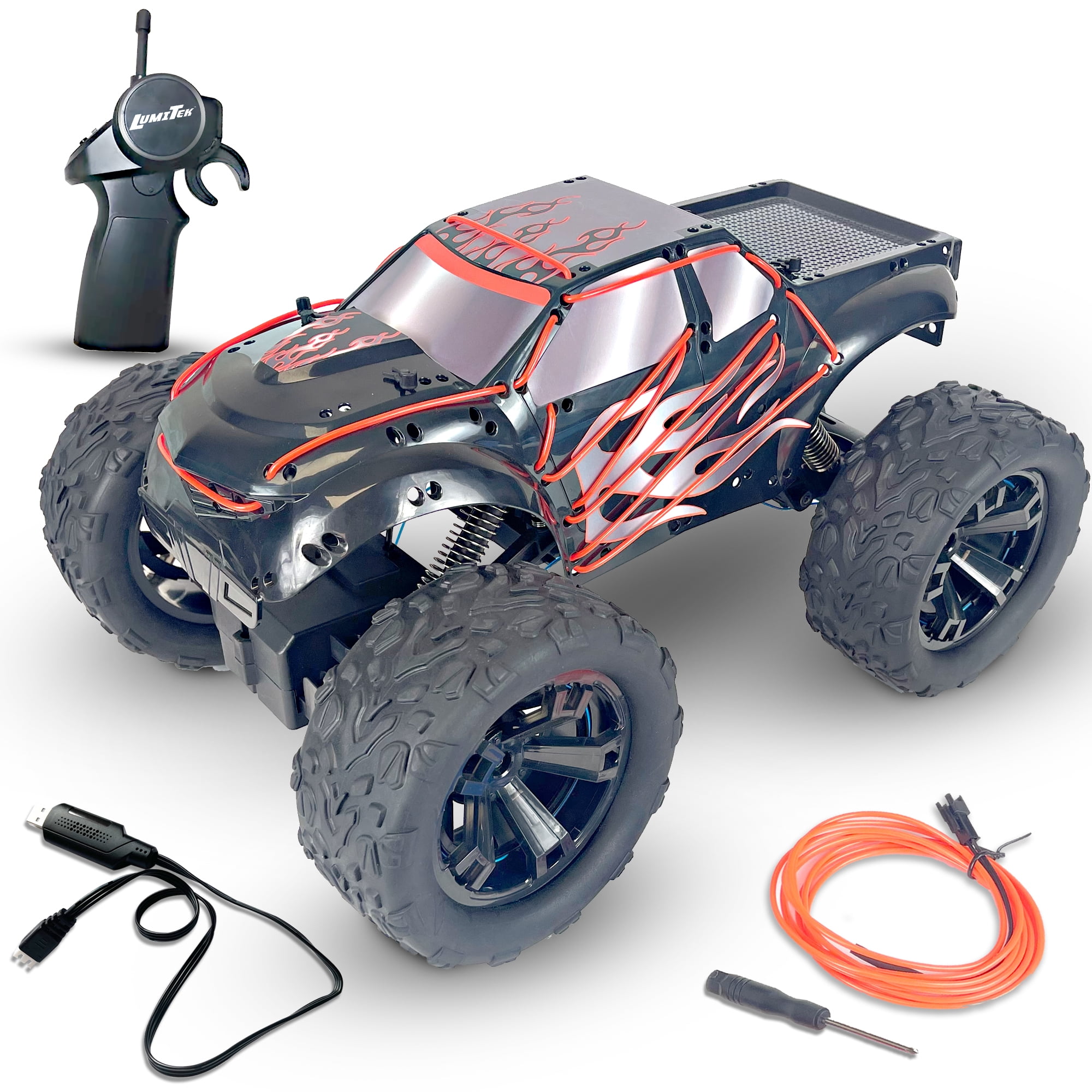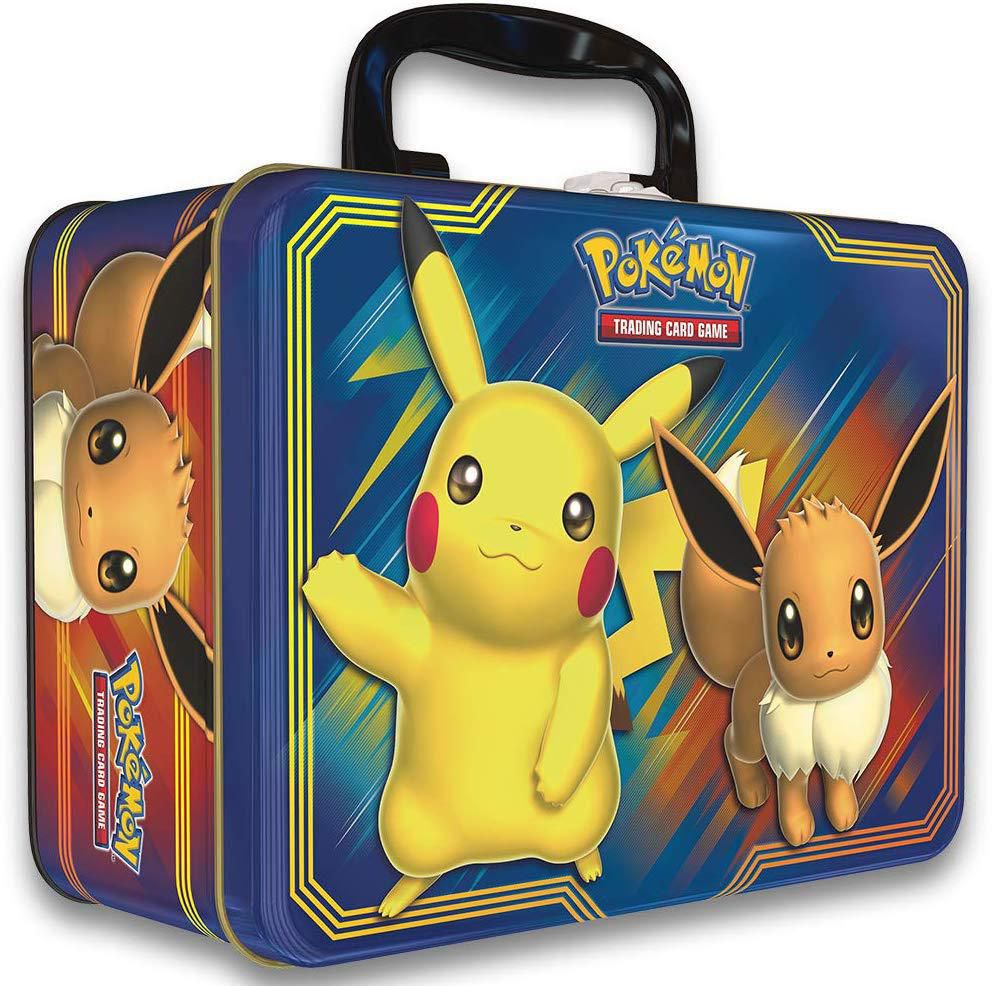LumiTEK™ R/C – Neon Giant Truck – Customizable LED Piping- 2.4 GHz 1:10 Scale Remote Control Car – Ages 8+
GREAT GIFT FOR KIDS: Whether you are looking for the perfect Christmas or birthday gifts for boys and girls, this light up Monster Truck set is guaranteed to be a total hit. The trucks come packed in a colorful box to spark excited looks at first glimpse. Includes: 1* Remote Control Car LumiTek™, 1* Controller, 1* USB Cable, 1* User Manual, 1* Screwdriver, 2* 7.4V 500mAH Battery. 1:10 Scale large size and full proportional super-fast RC cars monster truck! Exciting and extra cool gift for both kids and adults, LumiTek™ surely give them an extraordinary playing feel!
- LumiTek takes off-road riding, speed boat action, and lightning-fast racers and adds customizable chassis and controllable neon lighting, for a thrilling experience you’ll never forget!
- LumiTek is a fresh twist on RC that takes toyetic vehicles to the next level with futuristic light technology. Kids and adults will light up the night with blazing speed and customizable light-up excitement!
- Predrilled holes for custom LED designs
Product includes:
This High-speed light up LumiTEK™ RC car has slick rear wheels for awesome drifting and durability. Equipped with steady chassis and strong power motor, the speedy 2.4 GHz 1:10 scale remote control car is super fast than other RC cars. Just install the battery and turn on the switch, then you will enjoy an excitement racing time.
- Drive system: 4WD
- Stunt action: Wheelie bar
- Frequency: 2.4GHz
- Control Distance: about 164ft
- Running time: 20 minutes per battery
- Vehicle Battery: 7.4V/500 mAh battery (included)
- Remote Control Battery: 2 x 1.5V AA battery (not included)
Additional information
| Gender | Unisex |
|---|---|
| Color | Multi |
| Assembled Product Weight | 2.2 lb |
| Assembled Product Dimensions (L x W x H) | 15.00 x 6.50 x 4.17 Inches |
1 (one, unit, unity) is a number representing a single or the only entity. 1 is also a numerical digit and represents a single unit of counting or measurement. For example, a line segment of unit length is a line segment of length 1. In conventions of sign where zero is considered neither positive nor negative, 1 is the first and smallest positive integer. It is also sometimes considered the first of the infinite sequence of natural numbers, followed by 2, although by other definitions 1 is the second natural number, following 0.
The fundamental mathematical property of 1 is to be a multiplicative identity, meaning that any number multiplied by 1 equals the same number. Most if not all properties of 1 can be deduced from this. In advanced mathematics, a multiplicative identity is often denoted 1, even if it is not a number. 1 is by convention not considered a prime number; this was not universally accepted until the mid-20th century. Additionally, 1 is the smallest possible difference between two distinct natural numbers.
The unique mathematical properties of the number have led to its unique uses in other fields, ranging from science to sports. It commonly denotes the first, leading, or top thing in a group.
10 (ten) is the even natural number following 9 and preceding 11. Ten is the base of the decimal numeral system, the most common system of denoting numbers in both spoken and written language.
2 (two) is a number, numeral and digit. It is the natural number following 1 and preceding 3. It is the smallest and only even prime number. Because it forms the basis of a duality, it has religious and spiritual significance in many cultures.
4 (four) is a number, numeral and digit. It is the natural number following 3 and preceding 5. It is a square number, the smallest semiprime and composite number, and is considered unlucky in many East Asian cultures.
Ages may refer to:
- Advanced glycation end-products, known as AGEs
- Ages, Kentucky, census-designated place, United States
- Ages (album) by German electronic musician Edgar Froese
- The geologic time scale, a system of chronological measurement that relates stratigraphy to time
- Arnold Ages (1935-2020), Canadian scholar, writer, and journalist
C, or c, is the third letter of the Latin alphabet, used in the modern English alphabet, the alphabets of other western European languages and others worldwide. Its name in English is cee (pronounced ), plural cees.
A car, or an automobile, is a motor vehicle with wheels. Most definitions of cars state that they run primarily on roads, seat one to eight people, have four wheels, and mainly transport people, not cargo.
The French inventor Nicolas-Joseph Cugnot built the first steam-powered road vehicle in 1769, while the Swiss inventor François Isaac de Rivaz designed and constructed the first internal combustion-powered automobile in 1808. The modern car—a practical, marketable automobile for everyday use—was invented in 1886, when the German inventor Carl Benz patented his Benz Patent-Motorwagen. Commercial cars became widely available during the 20th century. One of the first cars affordable by the masses was the Ford Model T, begun in 1908, an American car manufactured by the Ford Motor Company. Cars were rapidly adopted in the US, where they replaced horse-drawn carriages. In Europe and other parts of the world, demand for automobiles did not increase until after World War II. The car is considered an essential part of the developed economy.
Cars have controls for driving, parking, passenger comfort, and a variety of lamps. Over the decades, additional features and controls have been added to vehicles, making them progressively more complex. These include rear-reversing cameras, air conditioning, navigation systems, and in-car entertainment. Most cars in use in the early 2020s are propelled by an internal combustion engine, fueled by the combustion of fossil fuels. Electric cars, which were invented early in the history of the car, became commercially available in the 2000s and are predicted to cost less to buy than petrol-driven cars before 2025. The transition from fossil fuel-powered cars to electric cars features prominently in most climate change mitigation scenarios, such as Project Drawdown's 100 actionable solutions for climate change.
There are costs and benefits to car use. The costs to the individual include acquiring the vehicle, interest payments (if the car is financed), repairs and maintenance, fuel, depreciation, driving time, parking fees, taxes, and insurance. The costs to society include maintaining roads, land-use, road congestion, air pollution, noise pollution, public health, and disposing of the vehicle at the end of its life. Traffic collisions are the largest cause of injury-related deaths worldwide. Personal benefits include on-demand transportation, mobility, independence, and convenience. Societal benefits include economic benefits, such as job and wealth creation from the automotive industry, transportation provision, societal well-being from leisure and travel opportunities, and the generation of revenue from taxation. People's ability to move flexibly from place to place has far-reaching implications for the nature of societies. There are around one billion cars in use worldwide. Car usage is increasing rapidly, especially in China, India, and other newly industrialised countries.
In folklore, giants (from Ancient Greek: gigas, cognate giga-) are beings of humanoid appearance, but are at times prodigious in size and strength or bear an otherwise notable appearance. The word giant is first attested in 1297 from Robert of Gloucester's chronicle. It is derived from the Gigantes (Greek: Γίγαντες) of Greek mythology.
Fairy tales such as Jack the Giant Killer have formed the modern perception of giants as dimwitted and violent ogres, sometimes said to eat humans, while other giants tend to eat livestock. In more recent portrayals, like those of Jonathan Swift and Roald Dahl, some giants are both intelligent and friendly.
Neon is a chemical element; it has symbol Ne and atomic number 10. It is the second noble gas in the periodic table. Neon is a colorless, odorless, inert monatomic gas under standard conditions, with approximately two-thirds the density of air.
Neon was discovered in 1898 alongside krypton and xenon, identified as one of the three remaining rare inert elements in dry air after the removal of nitrogen, oxygen, argon, and carbon dioxide. Its discovery was marked by the distinctive bright red emission spectrum it exhibited, leading to its immediate recognition as a new element. The name neon originates from the Greek word νέον, a neuter singular form of νέος (neos), meaning 'new'. Neon is a chemically inert gas, with no known uncharged neon compounds. Existing neon compounds are primarily ionic molecules or fragile molecules held together by van der Waals forces.
The synthesis of most neon in the cosmos resulted from the nuclear fusion within stars of oxygen and helium through the alpha-capture process. Despite its abundant presence in the universe and Solar System—ranking fifth in cosmic abundance following hydrogen, helium, oxygen, and carbon—neon is comparatively scarce on Earth. It constitutes about 18.2 ppm of Earth's atmospheric volume and a lesser fraction in the Earth's crust. The high volatility of neon and its inability to form compounds that would anchor it to solids explain its limited presence on Earth and the inner terrestrial planets. Neon’s high volatility facilitated its escape from planetesimals under the early Solar System's nascent Sun's warmth.
Neon's notable applications include its use in low-voltage neon glow lamps, high-voltage discharge tubes, and neon advertising signs, where it emits a distinct reddish-orange glow. This same red emission line is responsible for the characteristic red light of helium–neon lasers. Although neon has some applications in plasma tubes and as a refrigerant, its commercial uses are relatively limited. It is primarily obtained through the fractional distillation of liquid air, making it significantly more expensive than helium due to air being its sole source.
Within industry, piping is a system of pipes used to convey fluids (liquids and gases) from one location to another. The engineering discipline of piping design studies the efficient transport of fluid.
Industrial process piping (and accompanying in-line components) can be manufactured from wood, fiberglass, glass, steel, aluminum, plastic, copper, and concrete. The in-line components, known as fittings, valves, and other devices, typically sense and control the pressure, flow rate and temperature of the transmitted fluid, and usually are included in the field of piping design (or piping engineering), though the sensors and automatic controlling devices may alternatively be treated as part of instrumentation and control design. Piping systems are documented in piping and instrumentation diagrams (P&IDs). If necessary, pipes can be cleaned by the tube cleaning process.
Piping sometimes refers to piping design, the detailed specification of the physical piping layout within a process plant or commercial building. In earlier days, this was sometimes called drafting, technical drawing, engineering drawing, and design, but is today commonly performed by designers that have learned to use automated computer-aided drawing or computer-aided design (CAD) software.
Plumbing is a piping system with which most people are familiar, as it constitutes the form of fluid transportation that is used to provide potable water and fuels to their homes and businesses. Plumbing pipes also remove waste in the form of sewage, and allow venting of sewage gases to the outdoors. Fire sprinkler systems also use piping, and may transport nonpotable or potable water, or other fire-suppression fluids.
Piping also has many other industrial applications, which are crucial for moving raw and semi-processed fluids for refining into more useful products. Some of the more exotic materials used in pipe construction are Inconel, titanium, chrome-moly and various other steel alloys.
R, or r, is the eighteenth letter of the Latin alphabet, used in the modern English alphabet, the alphabets of other western European languages and others worldwide. Its name in English is ar (pronounced ), plural ars, or in Ireland or .
The letter ⟨r⟩ is the eighth most common letter in English and the fourth-most common consonant, after ⟨t⟩, ⟨n⟩, and ⟨s⟩.
A truck or lorry is a motor vehicle designed to transport freight, carry specialized payloads, or perform other utilitarian work. Trucks vary greatly in size, power, and configuration, but the vast majority feature body-on-frame construction, with a cabin that is independent of the payload portion of the vehicle. Smaller varieties may be mechanically similar to some automobiles. Commercial trucks can be very large and powerful and may be configured to be mounted with specialized equipment, such as in the case of refuse trucks, fire trucks, concrete mixers, and suction excavators. In American English, a commercial vehicle without a trailer or other articulation is formally a "straight truck" while one designed specifically to pull a trailer is not a truck but a "tractor".
The majority of trucks currently in use are still powered by diesel engines, although small- to medium-size trucks with gasoline engines exist in the US, Canada, and Mexico. The market-share of electrically powered trucks is growing rapidly, expected to reach 7% globally by 2027, and electric motive force already predominates among both the largest and smallest trucks. In the European Union, vehicles with a gross combination mass of up to 3.5 t (3.4 long tons; 3.9 short tons) are known as light commercial vehicles, and those over as large goods vehicles.






Reviews
There are no reviews yet.